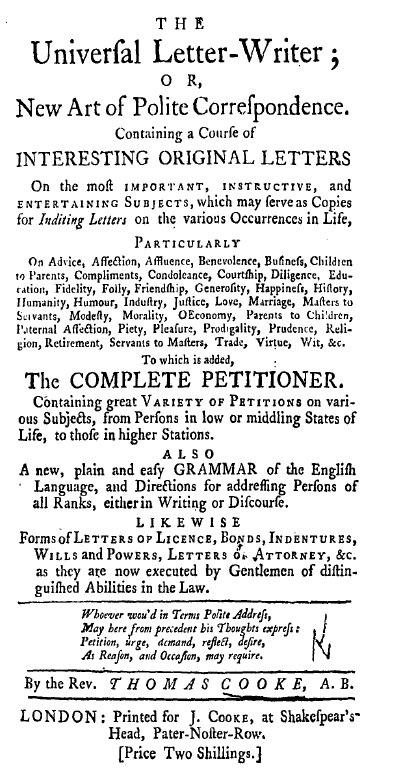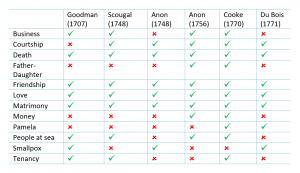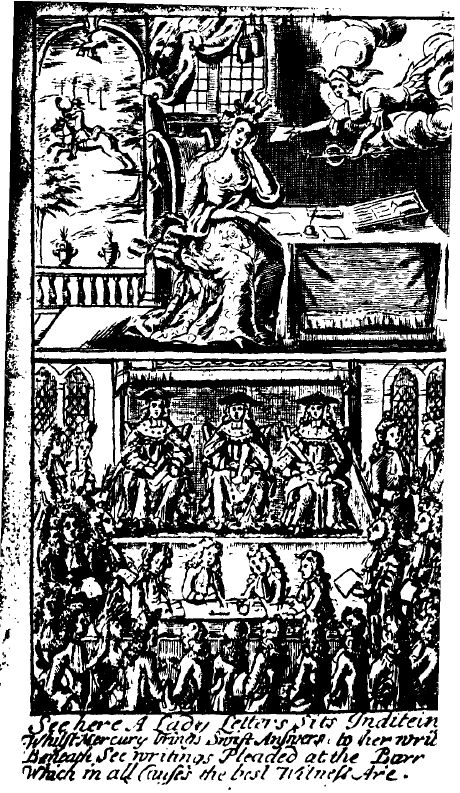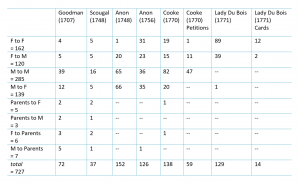In our autumn blog post, team Hamilton’s Nuria Yáñez-Bouza reports on the study by her BA dissertation student Celia Castro-Vázquez at the University of Vigo (2021). It is framed within Research Strand III of the project, and constitutes a nice example of how to integrate research into teaching at UG level.
When I first described to Celia the sources with which we work in our research strand ‘Norms and Usage’, I addressed both the letter edition we are compiling for the usage analysis and the letter-writing manuals for the study of norms. Celia immediately became interested in the latter, and she was particularly fascinated with the paratext: the richness of the layout of the title pages and the significance of the frontispieces. She thus set out to examine six letter-writing manuals with the aim of exploring the contents of the letters offered as samples, the target audience, and any other aspect highlighted by the authors in the prefatory material that would help persuade the reader to buy the work (Genette 1997), in the like manner that they appealed to her. In this blog we provide a summary of the most interesting observations drawn in Celia’s study.
Letter writing was highly important in eighteenth-century society both in the context of familiar correspondence and official correspondence (Barton & Hall 2000, Whyman 2009). For instance, reading correspondence from family and friends was a social activity where members of the household would come together to read the letters for entertainment, comment on news and gossip, or discuss politics and other matters of interest. Furthermore we can observe a rise in epistolary novels in this century (see Brant 2006 for themes connecting eighteenth-century letter writing and British culture). In the context of the increased regularisation and standardisation of both written and spoken English (Beal 2004), it is no surprise that linguistic and stylistic propriety in the composition of letters became more highly valued (Auer et al. 2015). Thus in concert with grammar books and pronouncing dictionaries, letter-writing manuals provided ‘directions for writing letters on all occasions, in a polite, easy, and proper Manner’ (Anon 1756: title page), and were characterised by lengthy lists of ‘elegant’ and ‘polite’ epistles offered as illustrative examples for ‘the embellishment of style’ (Anon 1768: title page). The publication of letter-writing manuals grew considerably in the course of the eighteenth century parallel to the remarkable increase in correspondence practices, including reprints and new editions of seventeenth-century works (Bannet 2005). Thus the sources studied in Celia’s dissertation, all of which were printed in London, include two items published in the early decades of the eighteenth century which were originally published in the late seventeenth century, two from the mid eighteenth-century decades, and two from the latter part of the century.
- Thomas Goodman, The Experienc’d Secretary: or, Citizen and Countryman’s Companion (1699 [1707, 4th ed.])
- Henry Scougal, A New Academy of Compliments: or, the Compleat English Secretary (1663 [1748])
- Anon, Polite Epistolary Correspondence. A Collection of Letters, on the Most Instructive and Entertaining Subjects (1748)
- Anon, The Complete Letter-Writer: or, New and Polite English Secretary (1755 [1756, 2nd ed.])
- Thomas Cooke, The Universal Letter-Writer; or, New Art of Polite Correspondence (1770)
- Lady Dorothea Du Bois, The Lady’s Polite Secretary, or New Female Letter Writer (1771)
Those familiar with eighteenth-century publications will know that title pages tend to be very comprehensive, and the art of printing furnished publishers with different fonts and formats to highlight keywords attractive to the potential reader (Yáñez-Bouza 2017). Letter-writing manuals are no less important and thus often include a complete list of the topics to be addressed in the letter samples of the manual. Cooke’s title page from 1770 in the illustration below lists forty of them, “&c.”.

Thomas Cooke (1770) The Universal Letter-Writer; or, New Art of Polite Correspondence (title page).
In the six items selected for this study, the most common themes are love, relationships, and death. Letters of consolation, of friendship, and of excuse or thanks are also a regular feature. For instance, in Goodman (1707) the table of contents includes a “Letter of Consolation to a Friend in Adversity”, a “Letter of Reproof from a Father to an Ungracious Son”, and a “Letter of a Daughter to her Parents, for marrying without consent”. In Scougal’s (1748) manual we find examples like “A Letter of Consolation to a Gentleman, upon the Death of his Wife” and “A Letter of Consolation to a Widow, upon the Death of her Husband” (pp. 23-26); in both cases the answers are presented as well. Since death is inevitable, it would be crucial to be able to approach the situation accordingly, they said. In Anon (1748) there is a letter entitled “The Necessity of being prepared for Death” (p. 132), which suggests that it was included with the purpose of emphasising how people should not ignore death but confront it, perhaps as an example of moral behaviour. In this volume we also find another letter with a moral tone: “Examples of Ingratitude ought not to hinder us from doing Good”. In Anon (1756) there are many sample letters about marriage, some of these include “From a Daughter to her Father, wherein she dutifully expostulates against a Match he had proposed to her, with a Gentleman much older than herself”; at the time, circumstances similar to this would be frequent and would provide an example for women to write to their parents. Lady Du Bois (1771) incorporated letters on the same topic and thus we are presented with “From Miss Stevenson to her Father, who had promised her in Marriage to a Gentleman whom she could not love”. In Cooke’s (1770) manual the titles of the letters are generally shorter and more direct: “A Declaration of Love”, “Fidelity acknowledged”, and “A humorous Love Letter” are common examples of this. This kind of precision would be helpful for readers who would be looking for a distinct scene without much focus on the writer or recipient.
Domestic topics in letters begin to appear in letter-writing manuals in the seventeenth century. In the eighteenth century, they become increasingly popular and one of the reasons for this is that the scope of the target audience of the manuals expands to consider not only the upper ranks but also the middle and, occasionally, the lower ranks. For their part, business letters appear in four of the six manuals selected, the exceptions being Lady Du Bois (1771) and Anon (1748). The absence of this type of letter in the former manual can be explained by the fact that it targets women, and, at the time, tasks relating to business would not be appropriate for women’s role in society. Regarding the latter, the manual explicitly indicates that it is a collection of letters on personal matters. Money is a very frequent topic as well, not so much in the business context as on a personal level. We find instances of letters between friends and family asking for money, for example, “Soliciting Money from a Friend” and “Soliciting Pocket-Money in support of modest Frugality” in Cooke (1770), and “To an intimate Acquaintance, to borrow Money” in the anonymous manual from 1756. Another related topic is tenancy agreements, listed in three out of the six manuals explored. References to smallpox are recurrent in manuals throughout the century, as this was a very serious and common illness at the time. In Goodman’s (1707) manual, for instance, there is a letter entitled “A Letter to a Lady much grieved for the impairing her Beauty by the Small Pox”; in the anonymous manual (1748) we find “Just recovered of the Small-Pox, who was preserved from being marked, by a Remedy prescribed by the Author”; and in Du Bois (1771) there is “From the Same to the Same, on hearing her disorder proved to be the Small-Pox, and that she had recovered with the loss of her Beauty”. Based on these titles, we can appreciate the similarities between the letters: they are all forwarded to a woman and written by a man, except the latter (as it is from Du Bois’s manual), and the focus of the letters is not on the illness itself but on the woman’s beauty; in two of them beauty has been lost due to the scars left.
One of the most captivating findings identified in the list of samples is the presence of letters relating to Samuel Richardson’s epistolary novel Pamela, a highly successful work published in 1740. In Cooke’s (1770) manual, two letters describe a situation similar to that of the main character in the novel. In Cooke’s narrative, a young servant is harassed by the son of her employer and writes a letter to the lady of the house where she describes how he had offered her money for her virtue, and how despite this being “a strong temptation”, she had declined his proposal and left the house. In the answer to this letter, the lady of the house praises the young servant for her actions while condemning her own son’s, and indicates that she will send a messenger with her clothes and a hundred pounds. Cooke labels these letters in the table of contents as “Virtue Rewarded”, which was part of the title of Richardson’s Pamela. However, this was not the narrative in the original epistolary novel. For her part, Du Bois presents a letter entitled “From Mrs. Morris to Mrs. Jones in the style of Pamela. Another instance of the ridiculous”. From the title alone, we perceive the tone of the letter and the author’s opinion about the book – in this case, the letter criticises the novel overtly and Mrs. Morris, the writer of the sample letter, refers to three questionable moments in Pamela’s story and remarks that she wants to send them to Richardson.
By way of summary, the following table gives an overview of the main themes addressed in the eighteenth-century letter-writing manuals that Celia examined in her study:

Table 1
A distinct characteristic of letter-writing manuals is the section dedicated to the proper manner of addressing people depending on their title or position in society, a component which is often explicitly advertised on the title page as a marketing strategy. For instance, Cooke’s (1770: title page) manual includes ‘Directions for addressing persons of all ranks, either in Writing or Discourse’. The importance of using the ‘proper’ form of address is clearly stated in Goodman’s (1707: 58) manual, which asserts that “in directing your letters, you must be very wary for a little mistake may give you disgust, and spoil all, especially with those of the higher ranks”. Scougal (1748: 40) made a similar remark as follows: “and if you know not how to superscribe your Letters by the proper Appellation or Titles of Honour, you will be at a great Loss”. In the anonymous work from 1756 we find the most extensive segment of this kind, divided in smaller sections each devoted to a social group, for instance “to the nobility”, “to the Parliament”, or “to the Clergy” (pp. 12-13). The author explains that the section is incorporated in the manual because young people are “liable to great mistakes” when addressing superiors and they “shall in this place give them suitable directions of address” (p. 11).

Thomas Goodman (1699 [1707, 4th ed.]), The Experienc’d Secretary: or, Citizen and Countryman’s Companion (frontispiece)

Table 2
References
Anon. 1768 [1755]. The complete letter-writer. Containing familiar letters on the most common occasions in life, also a variety of elegant letters for the direction and embellishment of style, on business, duty, amusement, love, courtship, marriage, friendship, and other subjects. Edinburgh: Printed by John Reid. For W. Darling, at the head of Skinner’s Close.
Auer, Anita, Daniel Schreier & Richard J. Watts (eds.). 2015. Letter writing and language change. Cambridge: Cambridge University Press.
Bannet, Eve Tavor. 2005. Empire of letters: Letter manuals and transatlantic correspondence, 1680-1820. Cambridge: Cambridge University Press.
Barton, David & Nigel Hall (eds.). 2000. Letter writing as a social practice. Amsterdam & Philadelphia: John Benjamins.
Beal, Joan C. 2004. English in modern times 1700-1945. London: Arnold.
Brant, Clare. 2006. Eighteenth-century letters and British culture. Basingstoke: Palgrave Macmillan.
Castro-Vázquez, Celia. 2021. 18th-century letter-writing manuals: a comparative study. BA dissertation, Degree in Foreign Languages, Universidade de Vigo.
Genette, Gérard. 1997. Paratexts. Thresholds of interpretation. [English translation, 1987.] Cambridge: Cambridge University Press.
Yáñez-Bouza, Nuria. 2017. Paratext, title-pages and grammar books. Studia Neophilologica 89(1), 41-66.
Nuria Yáñez-Bouza & Celia Castro-Vázquez (Universidade de Vigo)
November 2021
